The traditional colour of suits is red for Diamonds and Hearts, and black for Clubs and Spades.
But a few variants of this scheme do exist.
The picture on the right shows a German deck whose suits have four different colours: Hearts are red, Diamonds are yellow, Spades are blue and Clubs are black. This apparently odd combination is called Turnierbild ("tournament pattern"), and it is officially used in the final stage of the German Skat Championship. Since most players prefer to use the Berliner Bild (with French suits), this pattern maintains this design, although not to displease the minority of players who prefer the Neues Altenburg (German-suited) pattern, the colours of the suits recall Hearts (red), Leaves (green), Bells (yellow) and Acorns (black). |
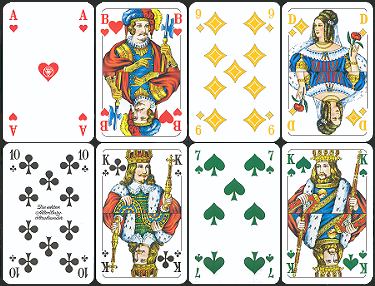
Turnierbild deck, by ASS (Germany): this is
an official pattern for Skat tournaments |
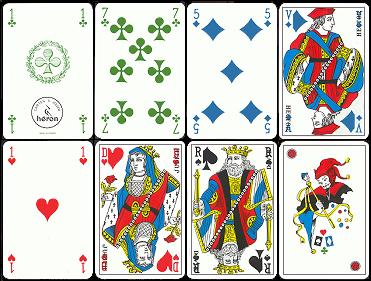
Atoucouleur deck, by Héron (France): a traditional
French pattern with suits in four different colours
|
|
Besides official tournaments, in some games it may be useful to tell the different suits both by their sign and by their colour. Two more examples are the four-colour edition of the national French pattern, called Atoucouleur, made by Héron (left), or the Piquet pattern by the Swiss manufacturer AG Müller (below), named Opti-piquet. In this case the colour scheme is green for Clubs, red for Hearts, pale blue for Diamonds and black for Spades. |
Opti-piquet, four-colour edition of the
French-suited Jass pattern,
by AG Müller (Switzerland) |
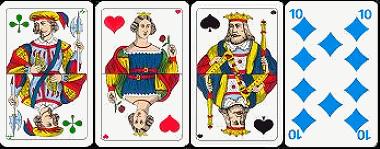 |
Any other scheme should be considered a non-standard variety. For instance,
the deck shown on the right is a fancy edition with reverse colours, so Hearts and Diamonds are black,
whereas Clubs and Spades are red.
The other sample shown below, instead, is printed in only two colours, i.e. black and red; the cards are made of thin paper, (not pasteboard), and their corners are not rounded. This deck, though, is more than an oddity for collectors. |
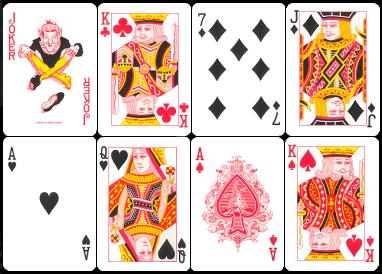
Reverse Color deck (made in Hong Kong by an unknown manufacturer) |
It comes from Singapore, but it is manufactured in Malaysia, for the numerous Chinese community that lives in South-east Asia.
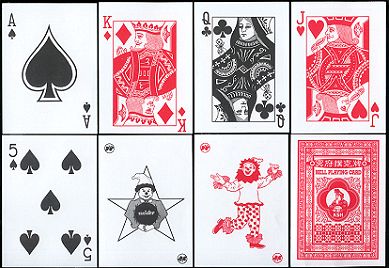
Hell Cards, for ceremonial purpose, by KSH (Malaysia) |
As collector Pwee Keng Ho explained in an article, published in the journal of the International Playing-Card Society, in this area it is customary to burn paper offerings for the souls of the departed, at funerals and other special occasions. Such offerings have the shape of everyday's objects; several specialized shops offer a great variety of paper items for this particular ceremonial purpose, and this deck of cards is one of them. The real purpose it is made for gives reason for its very essential features, although four jokers too are included, and the back is regularly printed, with a geometric motif and a label. |
The latter (see detail on the right) bears a rather surprising title, Hell Playing Card (sic), likely due to a very rough translation of its original name in Chinese, MingFu PuKe Pai, which means "Poker cards of the realm of the dead"; the personage in traditional clothes whose bust is featured in the centre is in fact the Jade Emperor, i.e. in Taoist belief, he who presides over the aforesaid realm.
|
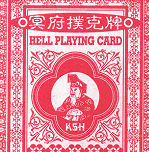 |
SIMPLY CURIOUS
Here is a deck which does not belong to any of the above mentioned categories, but is
still somewhat ...strange.
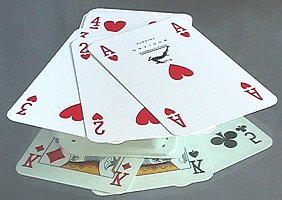 |
Produced by Modiano (Italy), its name is Doppio Gioco (double game),
after the game it is designed for.
On one side it looks like a standard 52-card pack, but there is no actual back: in fact, the
reverse too features ordinary values, although they are arranged in a different and apparently
random order.
No Joker belongs to this deck.
The picture on the right shows a few cards resting over a mirror, so that both sides are
visible. |
OTHER GALLERIES






















or back to

INTRODUCTION
AND HISTORY
|

MULTI-LANGUAGE
GLOSSARY |

THE FOOL &
THE JOKER |

INDEX
TABLE |

REGIONAL
GAMES |

PLAYING CARD
LINKS |